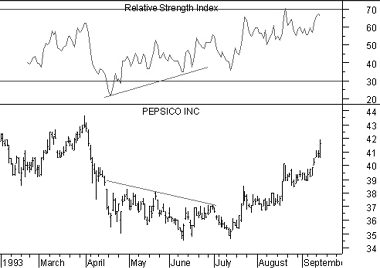
Technical Analysis from A to Z
by Steven B. Achelis
RELATIVE STRENGTH INDEX
Overview
The Relative Strength Index ("RSI") is a popular oscillator. It was first introduced by Welles Wilder in an article in Commodities (now known as Futures) Magazine in June, 1978. Step-by-step instructions on calculating and interpreting the RSI are also provided in Mr. Wilder's book, New Concepts in Technical Trading Systems.
The name "Relative Strength Index" is slightly misleading as the RSI does not compare the relative strength of two securities, but rather the internal strength of a single security. A more appropriate name might be "Internal Strength Index." Relative strength charts that compare two market indices, which are often referred to as Comparative Relative Strength.
Interpretation
When Wilder introduced the RSI, he recommended using a 14-day RSI. Since then, the 9-day and 25-day RSIs have also gained popularity. Because you can vary the number of time periods in the RSI calculation, I suggest that you experiment to find the period that works best for you. (The fewer days used to calculate the RSI, the more volatile the indicator.)
The RSI is a price-following oscillator that ranges between 0 and 100. A popular method of analyzing the RSI is to look for a divergence in which the security is making a new high, but the RSI is failing to surpass its previous high. This divergence is an indication of an impending reversal. When the RSI then turns down and falls below its most recent trough, it is said to have completed a "failure swing." The failure swing is considered a confirmation of the impending reversal.
In Mr. Wilder's book, he discusses five uses of the RSI in analyzing commodity charts. These methods can be applied to other security types as well.
- Tops and Bottoms.
The RSI usually tops above 70 and bottoms below 30. It usually forms these tops and bottoms before the underlying price chart.
- Chart Formations.
The RSI often forms chart patterns such as head and shoulders (page 215) or triangles (page 216) that may or may not be visible on the price chart.
- Failure Swings.
(also known as support or resistance penetrations or breakouts). This is where the RSI surpasses a previous high (peak) or falls below a recent low (trough).
- Support and Resistance.
The RSI shows, sometimes more clearly than price themselves, levels of support and resistance.
- Divergences.
As discussed above, divergences occur when the price makes a new high (or low) that is not confirmed by a new high (or low) in the RSI. Prices usually correct and move in the direction of the RSI.
For additional information on the RSI, refer to Mr. Wilder's book.
Example
The following chart shows PepsiCo and its 14-day RSI.

A bullish divergence occurred during May and June as prices were falling while the RSI was rising. Prices subsequently corrected and trended upward.
Calculation
The RSI is a fairly simple formula, but is difficult to explain without pages of examples. Refer to Wilder's book for additional calculation information. The basic formula is:

Where:
![]()
Contents
- Preface
- Acknowledgments
- Terminology
- To Learn More
- Bibliography
- About the Author
- Technical Analysis
- Price Fields
- Charts
- Support & Resistance
- Trends
- Moving Averages
- Indicators
- Market Indicators
- Line Studies
- Periodicity
- The Time Element
- Conclusion
- Absolute Breadth Index
- Accumulation/Distribution
- Accumulation Swing Index
- Advance/Decline Line
- Advance/Decline Ratio
- Advancing-Declining Issues
- Advancing, Declining, Unchanged Volume
- Andrews' Pitchfork
- Arms Index
- Average True Range
- Bollinger Bands
- Breadth Thrust
- Bull/Bear Ratio
- Candlesticks - Japanese
- CANSLIM
- Chaikin Oscillator
- Commodity Channel Index
- Commodity Selection Index
- Correlation Analysis
- Cumulative Volume Index
- Cycles
- Demand Index
- Detrended Price Oscillator
- Directional Movement
- Dow Theory
- Ease of Movement
- Efficient Market Theory
- Elliott Wave Theory
- Envelopes (Trading Bands)
- Equivolume/Candlevolume
- Fibonacci Studies
- Four Percent Model
- Fourier Transform
- Fundamental Analysis
- Gann Angles
- Herrick Payoff Index
- Interest Rates
- Kagi
- Large Block Ratio
- Linear Regression Lines
- MACD
- Mass Index
- McClellan Oscillator
- McClellan Summation Index
- Median Price
- Member Short Ratio
- Momentum
- Money Flow Index
- Moving Averages
- Negative Volume Index
- New Highs-Lows Cumulative
- New Highs-New Lows
- New Highs/Lows Ratio
- Odd Lot Balance Index
- Odd Lot Purchases/Sales
- Odd Lot Short Ratio
- On Balance Volume
- Open Interest
- Open-10 TRIN
- Option Analysis
- Overbought/Oversold
- Parabolic SAR
- Patterns
- Percent Retracement
- Performance
- Point & Figure
- Positive Volume Index
- Price and Volume Trend
- Price Oscillator
- Price Rate-of-Change
- Public Short Ratio
- Puts/Calls Ratio
- Quadrant Lines
- Relative Strength, Comparative
- Relative Strength Index
- Renko
- Speed Resistance Lines
- Spreads
- Standard Deviation
- STIX
- Stochastic Oscillator
- Swing Index
- Three Line Break
- Time Series Forcast
- Tirone Levels
- Total Short Ratio
- Trade Volume Index
- Trendlines
- TRIX
- Typical Price
- Ultimate Oscillator
- Upside/Downside Ratio
- Upside/Downside Volume
- Vertical Horizonal Filter
- Volatility, Chaikin's
- Volume
- Volume Oscillator
- Volume Rate-of-Change
- Weighted Close
- Williams' Accumulation/Distribution
- Williams' %R
- Zig Zag